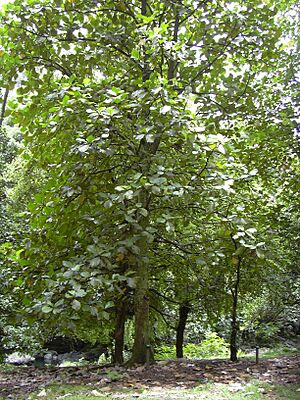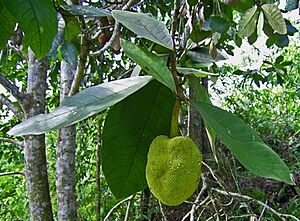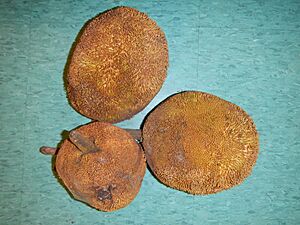Artocarpus odoratissimus facts for kids
Quick facts for kids Terap/Tarap/Marang |
|
|---|---|
 |
|
| Conservation status | |
| Scientific classification | |
| Genus: |
Artocarpus
|
| Species: |
odoratissimus
|
| Synonyms | |
|
|
Marang (scientific name: Artocarpus odoratissimus) is a type of flowering plant. It belongs to the same family as mulberry trees. People often call it by names like marang, tarap, or terap. This tree originally comes from places like Borneo, Palawan, and Mindanao Island. It is a close relative of other well-known fruits such as the jackfruit, cempedak, and breadfruit. All these trees are part of the same plant group called Artocarpus.
Contents
About the Marang Tree
The marang tree is an evergreen tree. This means it keeps its leaves all year round. It can grow very tall, up to about 25 meters (82 feet).
Its leaves are quite large. They can be 16 to 50 centimeters (6 to 20 inches) long. They are also 11 to 28 centimeters (4 to 11 inches) wide. The leaves look a bit like breadfruit leaves. However, they have fewer deep cuts or lobes. As the tree gets older, its leaves often become less lobed.
The Marang Fruit
The marang fruit has a very strong smell. This is why its scientific name includes "odoratissimus," which means "very fragrant." Many people think its flavor is even better than jackfruit or cempedak.
The smell might remind some people of durian. But it is not as strong. The strong scent comes from the thick skin, not the fruit inside. The outer skin has a very sharp, almost chemical-like smell.
The taste of the fruit is mild and creamy. It has a juicy texture, a bit like a longan fruit. You might also notice hints of jackfruit or cempedak flavor. There is a very mild aftertaste, similar to the outer skin's smell.
It is best to eat the fruit when it has not fully ripened on the tree. Fruits that ripen completely on the tree turn brownish. They will eventually fall to the ground and split open easily.
The marang fruit looks like a mix between a jackfruit and a breadfruit. It is usually round or oval-shaped. It can be 15 to 20 centimeters (6 to 8 inches) long. It is about 13 centimeters (5 inches) wide. Each fruit weighs around 1 kilogram (2.2 pounds).
The fruit's thick skin is covered with soft, wide spines. These spines become hard and brittle as the fruit ripens. When the fruit is fully ripe, the inside parts (called arils) expand. This makes the outer skin look lumpy. This happens especially if not all the seeds were pollinated.
The fruit does not fall from the tree until it is very ripe. You can pick it when it is full-sized but still firm. Then, let it ripen until it feels soft. Ripe fruits turn a greenish-yellow color.
To open a ripe marang fruit, you cut around the rind. Then, you twist and gently pull it apart. If the fruit is overripe, you can just pull it apart easily.
The inside of the fruit looks a bit like a jackfruit. However, the marang's flesh is white and usually softer. It has a relatively large core. But there are fewer stringy, non-edible parts. The edible parts, called arils, are white. They are about the size of a grape. Each aril contains a seed that is about 15 by 8 millimeters.
Once you open the fruit, you should eat it quickly. It tastes even better when chilled. The fruit loses its flavor fast and can turn brown. The seeds are also edible. You can eat them after boiling or roasting them.
Where Marang Grows
People grow Artocarpus odoratissimus for its fruit. It is grown in places like Brunei, Indonesia, Malaysia, the Philippines, southern Thailand, and Tripura in India.
Most of the marang fruit is grown for people to eat locally. This is because the fruit does not stay fresh for very long. This short shelf-life makes it hard to send the fruit to far-away places.
The marang tree does not like cold weather. It cannot grow in places where temperatures often drop below 7 °C (45 °F). It grows best in coastal areas. It can grow in regions between 15 degrees north and south of the equator.
Similar Fruits
There are other fruits that look very much like marang. These include Artocarpus sericarpus and Artocarpus sarawakensis. These fruits are often mistaken for marang. They also grow in the same areas.
However, you can tell them apart when they are ripe.
- Artocarpus sericicarpus has hairs on its skin. It looks a bit like a large rambutan. It ripens to a red color.
- Artocarpus sarawakensis is trickier to tell apart. It has the same shape as marang. But it ripens to an orange color. Its edible sections inside are also smaller.
Uses of Marang Waste
Even the leftover parts of the marang fruit can be useful. The peels, stem, and seeds can be used for different things.
For example, marang peels have been used to help clean dirty water. They can remove coloring agents, like dyes, from wastewater. The stem of the marang fruit has also been used. It can help remove harmful metals like cadmium and copper from water.
See Also
- Artocarpus integer
- Artocarpus camansi
- Artocarpus altilis





